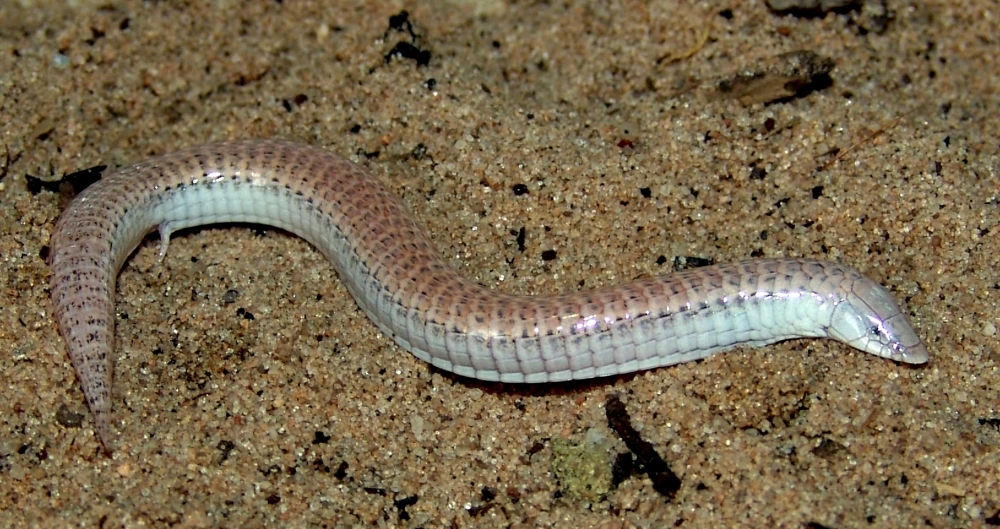


Calyptommatus sinebrachiatus, a lizard endemic to the dunes of the São Francisco River (Bahia state, Brazil), lost its limbs during evolution (photo: Miguel Trefaut Urbano Rodrigues/IB-USP)
Published on 10/24/2022
By André Julião | Agência FAPESP – Adapted to the dunes of the São Francisco River in the north of Bahia state, Northeast Brazil, the small lizard Calyptommatus sinebrachiatus stands out for the agility with which it captures prey and flees predators. Curiously, this agility may be due to lack of limbs, a rarity among lizards. The species belongs to one of 26 groups of animals with vestigial limbs or none at all, including snakes.
It might seem that loss of limbs occurred in the same manner in lizards and snakes when the two groups diverged some 100 million years ago, but in an article published in Cell Reports, researchers based in Germany and Brazil tell a somewhat more complex story.
“In a previous study on snakes, we found a very clear signature of genomic changes associated with genes involved in limb development. In lizards, this signature is less clear,” said Juliana Gusson Roscito, a project coordinator at Dresden University of Technology’s Genome Center in Germany, and principal investigator for both studies (more at: agencia.fapesp.br/29708).
In the more recent study, the group sequenced the genomes of C. sinebrachiatus and Tretioscincus oriximinensis, a related but limbed South American lizard. To detect differences that could explain the absence of limbs in lizards, they compared these with the genomes of another limbless lizard, Dopasia gracilis (a native of Asia), five snakes and seven limbed lizards, as well as 25 non-reptile species (mammals, birds and fish) representing other vertebrates.
“Rather than focusing on the genes that control limb formation and that are all present and intact in both limbless lizards and snakes, we looked for changes in regions that regulate the expression of these genes in terms of temporal or spatial patterns,” Roscito said. “We found that regulatory regions that are conserved in limbed vertebrates have undergone various mutations in limbless species. These regions are next to genes involved in limb formation, suggesting that limblessness in these species may be associated with changes in the regulation of gene expression rather than with the genes themselves.”
Different mechanisms can contribute to loss of limbs, and multiple evolutionary pathways probably led certain lizard species to become limbless, she added. In the three lineages of limbless lizards analyzed, the regulatory regions that underwent mutations were relatively different, suggesting that no single evolutionary route was responsible for loss of limbs.
Both the latest study and the previous one (on snakes) were part of a Thematic Project supported by FAPESP under the aegis of its Research Program on Biodiversity Characterization, Conservation, Restoration and Sustainable Use (BIOTA-FAPESP). The principal investigator for the Thematic Project is Miguel Trefaut Urbano Rodrigues, a professor at the University of São Paulo’s Institute of Biosciences (IB-USP) in Brazil and a co-author of the article.
Part of the study was conducted during Roscito’s postdoctoral research at IB-USP and while she was on a research internship at the Max Planck Institute for Molecular Cell Biology and Genetics in Dresden.
Differences
Analysis of the snake and lizard genomes revealed three of the 26 times limbs were lost or reduced during the evolution of Squamata, the order to which these two groups of reptiles belong.
“The regulatory regions are different. In snakes, the mutations are quite evident. They lost their limbs some 100 million years ago, long enough for genomes to accumulate many mutations. In these lizards, which became limbless between 30 million and 40 million years ago, the mutations are more ‘diluted’. This isn’t enough evolutionary time for an accumulation of mutations that might have enabled us to identify the possible molecular mechanism involved in the absence of limbs,” Roscito said.
Moreover, she added, the mutations are not located predominantly in the same regions as in the snake genomes. The elements that regulate the absence of limbs are specific to each reptile lineage, exemplifying what is known as convergent evolution, i.e. the independent evolution of similar traits in unrelated species by different evolutionary paths.
The article “Convergent and lineage-specific genomic differences in limb regulatory elements in limbless reptile lineages” is at: www.cell.com/cell-reports/fulltext/S2211-1247(21)01795-2.
Source: https://agencia.fapesp.br/39895